1989 Half Dollar Coin Value: How Much Is It Worth?
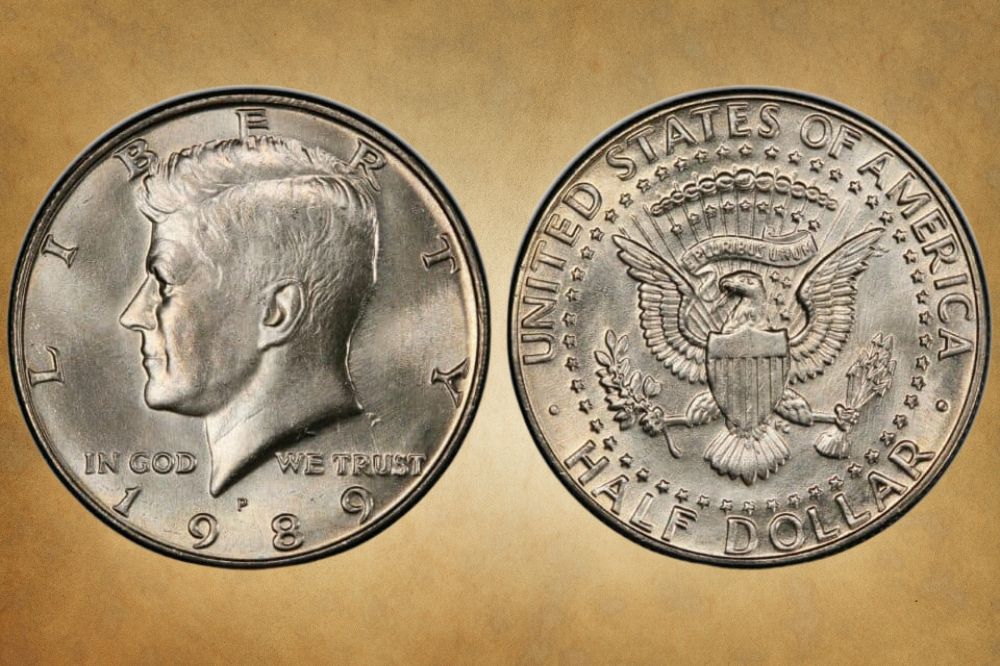
Do you wonder how much your 1989 Kennedy half dollar is worth?
You are not alone if you are excited about coming across this old coin. John Fitzgerald Kennedy was a popular modern president and most people are happy to own even a small souvenir commemorating the President.
If you are curious about the 1989 half dollar value, you’ve come to the right place. In this article, you will learn about the coin’s interesting history, unique features, and mint-related 1989 Kennedy error coins worth more than face value.
This coin is definitely worth having in your collection even just for its sentimental and historical significance.
So, let’s jump in!
1989 Half Dollar Value Chart |
||||
| Mint mark | Good | Fine | Extremely Fine | Uncirculated |
| 1989-P Half Dollar Value | 0.60 | 0.60 | 0.60 | $200 |
| 1989-D Half Dollar Value | 0.60 | 0.60 | 0.60 | $145 |
1989 Half Dollar Value Guide
In this section, you will find out how much your 1989 half dollar is worth. There are two varieties of this coin. The value of your half dollar will depend on factors such as the mintmark, mintage, and the coin’s overall condition.
The two varieties of 1989 half dollars are:
- The 1989-P Half Dollar
- The 1989-D Half Dollar
Let’s look at each coin individually and find out how much they are worth.
The 1989-P Half Dollar Value
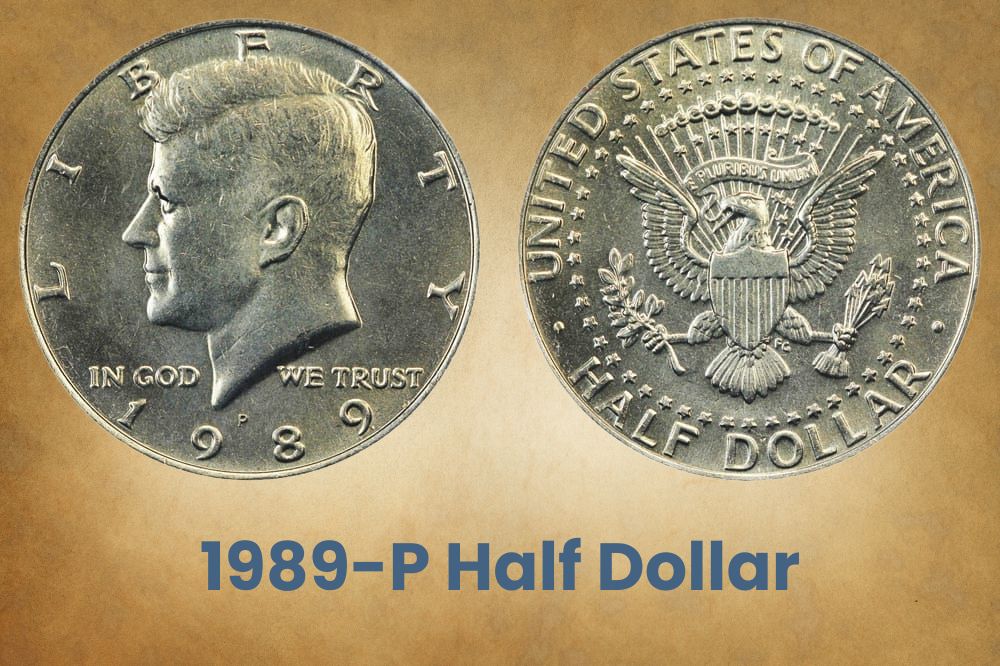
The Philadelphia mint struck an estimated 24, 542,000 Kennedy dollars in 1989.
As you might already guess, this is a high mintage, so these coins are common in circulated and uncirculated conditions.
That said, in Mint State (MS) 67 and above, it is quite difficult and expensive to obtain the Kennedy dollars minted in Philadelphia in 1989.
In circulated condition, the 1989 half dollar value is worth slightly more than the face value and ranges between $0.60 and $0.75.
In mint state, your coin could be worth up to $200, depending on its condition. According to the Professional Coin Grading Service, the most expensive 1989-P half dollar is graded MS68 and sold for $3,350 in 2022.
The 1989-D Half Dollar Value
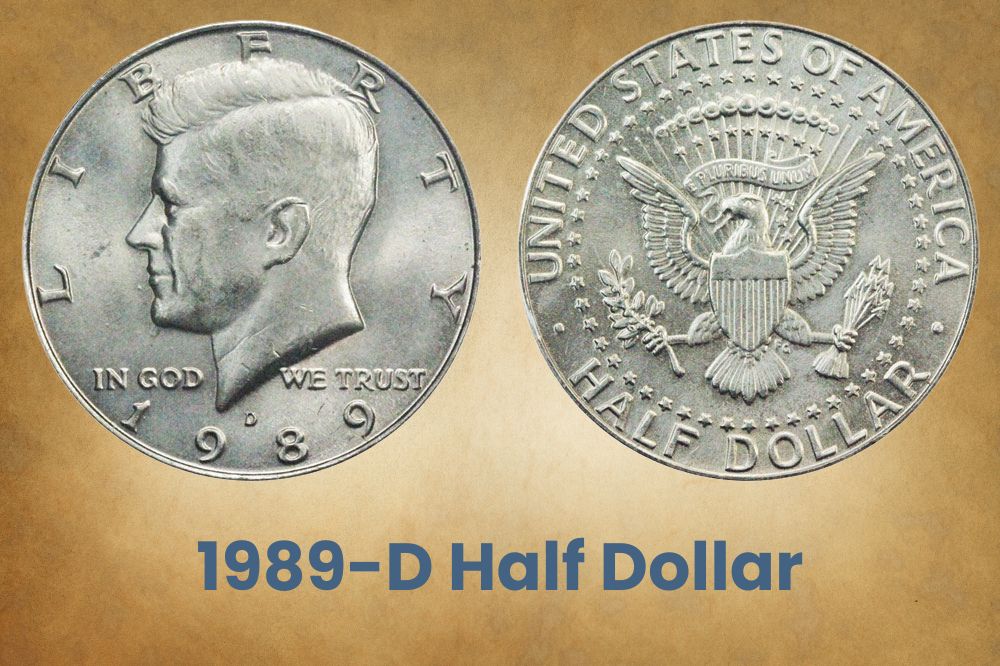
In 1989, the Denver mint produced about 23,000,216 Kennedy halves, keeping up with the high mintage common for this coin series. These coins have a D mint mark on the obverse right below the President’s portrait.
Due to the large number of coins produced that year, 1989 –D half dollars are quite common and easily accessible in both circulated and uncirculated conditions. From MS67, this coin is difficult to find and rare in grades higher than this, and it attracts a premium.
In circulated condition, a 1989-D Kennedy half dollar is worth slightly more than face value, ranging between $0.60 and $0.75.
In mint state, the 1989-D half dollar can fetch up to $145. The most expensive 1989 half dollar so far is graded MS67 and sold for $395 in 2019.
Related Posts: 26 Most Valuable Half Dollar Coins In Circulation
1989 Half Dollar Errors
Errors occur during the minting process due to old or damaged dies, improper placement of the planchet or blank coin on which the die strikes the design, or the presence of dust, debris, or grease.
Errors are interesting occurrences that fascinate collectors to the extent of increasing the value of a coin. Some error coins can be worth ten times more than the original strike, but this depends on the nature of the error, its size, location and sentimental or historical significance.
Starting from the 1980s, the Mint generally struck good quality coins with only a few errors and the year 1989 was no exception.
Although the coins at the Philadelphia and Denver mints were generally well-struck, there were a few notable errors.
Here are some 1989 half dollar errors worth noting:
1989 Struck Through Grease Half Dollar Error
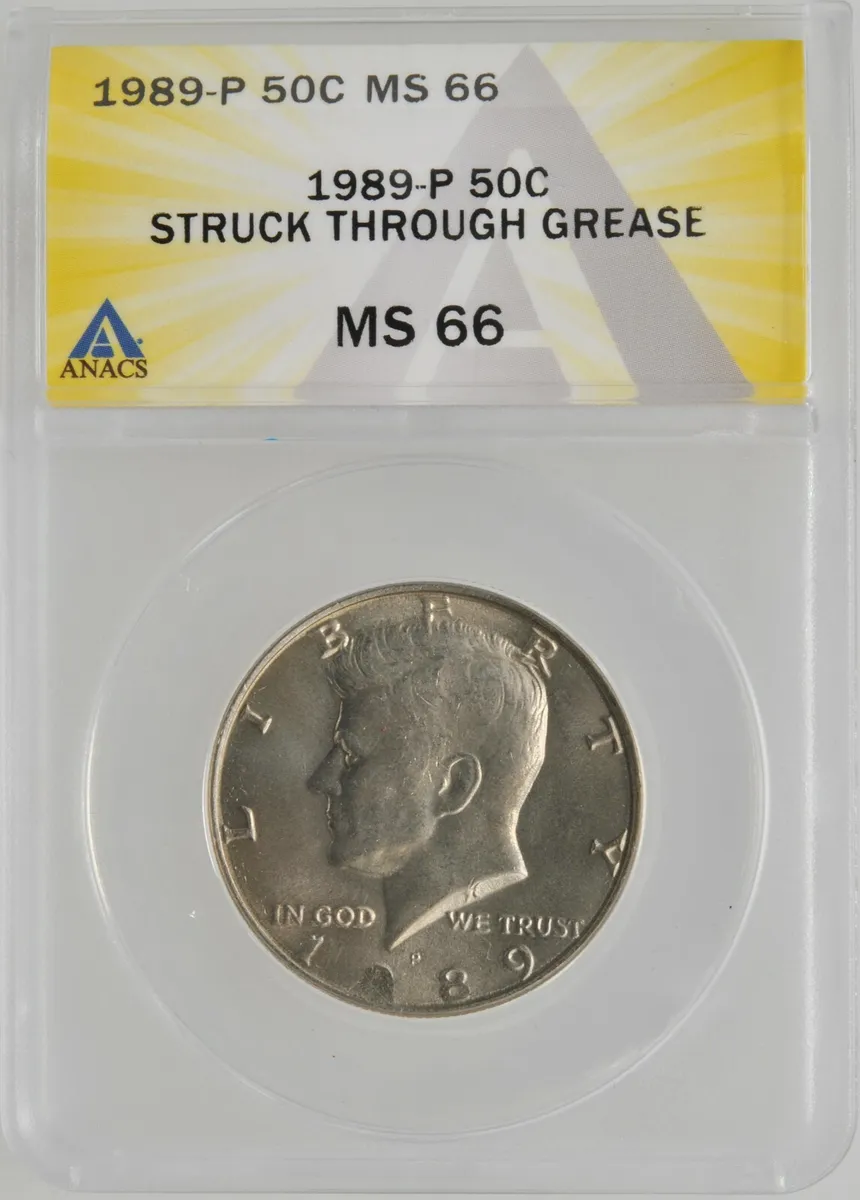
Grease is one of the foreign materials that can interfere with the coin-striking process. Sometimes, grease can build up inside the die recess.
The foreign material, which typically consists of dust, dirt, lubricant and other minute debris, can be viscous, smooth or hard and build up around certain elements of the coin’s design. When this happens, the result is a filled die error.
Sometimes the grease can cover the entire surface of the die. When the gunk is so thick, it can completely block out the coin’s design, and you could end up with a blank-looking coin except for subtle traces of the design.
The struck-through grease error is present in some 1989-P half dollars, with the grease lightly obscuring the President’s portrait on the obverse and the bald eagle on the reverse. The result is a dull 1989 Kennedy half dollar.
This error coin can fetch up to $43.
1989 Misaligned Half Dollar Error
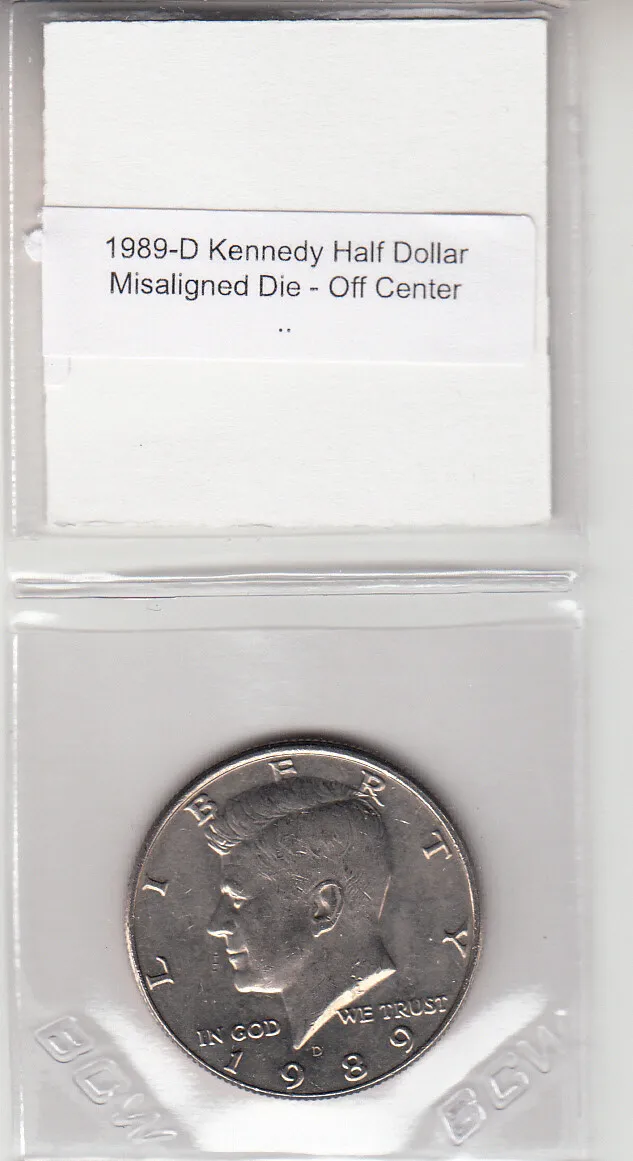
Another common error among the 1989-P coin variety is the misaligned error.
Not to be confused with the off-center strike error, the misaligned coin error occurs when the planchet is improperly placed into the striking hub so that the die sits on the coin’s collar partially.
The improper placement results in the design not appearing where it is supposed to, instead appearing at a slightly different angle.
The misaligned error is visible on the obverse of the 1989-P half dollar with the President’s profile appearing tilted forward and moved up so that Kennedy’s hair touches and overlaps the word LIBERTY.
Because misaligned errors are common, your 1989 half dollar error might not be worth as much. Expect to pay or fetch up to $7.
1989 Missing Star Half Dollar Error
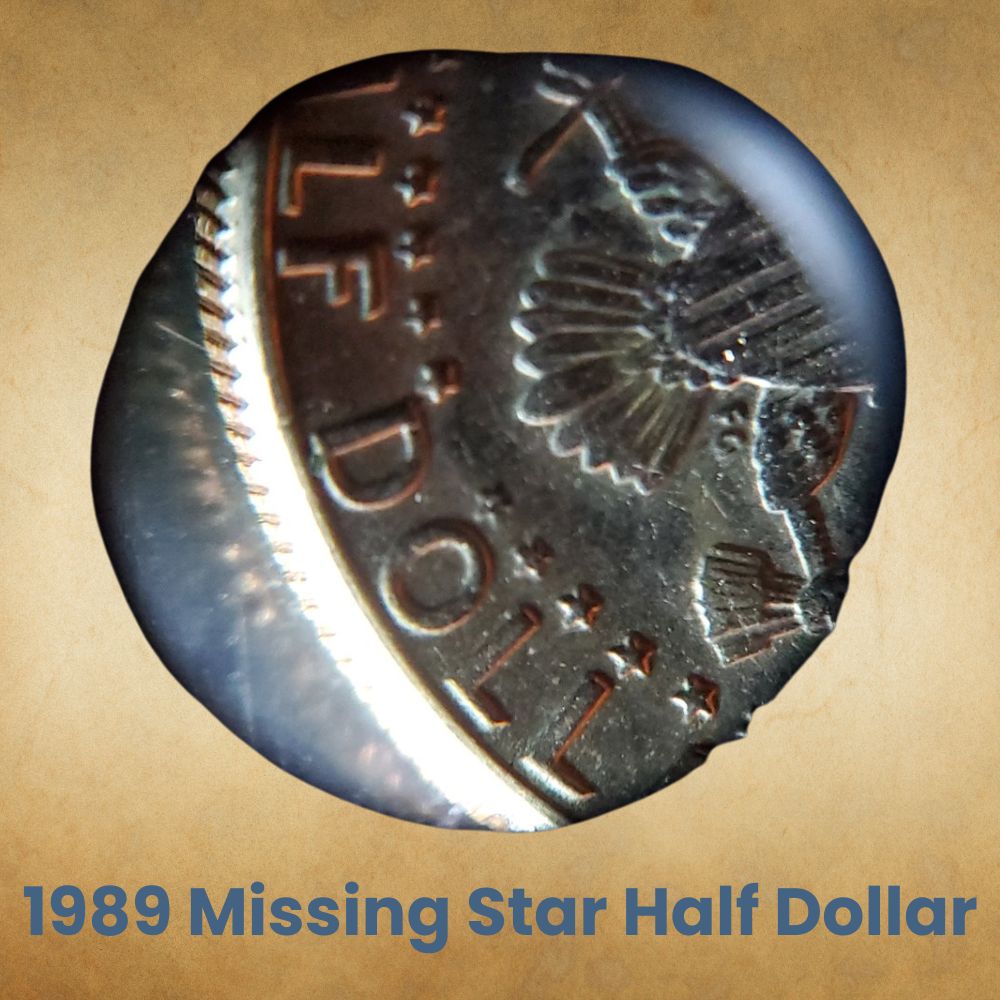
On the reverse of the 1989 half dollar, fifty stars encircle the bald eagle, with each star representing the fifty states.
As the name suggests, the missing star error simply means the die missed punching one of the stars. Grease, debris and other foreign material may have coated the die, preventing it from striking the star.
There is a lot of interest in the 1989 missing star half dollar error so this coin could potentially be worth hundreds or thousands of dollars!
Related Posts: 17 Most Valuable Kennedy Half Dollar Worth Money
History of the 1989 Half Dollar
The half dollar was a commemorative coin the U.S. Mint struck and distributed in 1964 on the heels of President John Fitzgerald Kennedy’s assassination.
Within days of the November 22, 1963 assassination, the U.S. Mint and U.S. Treasury commissioned designs for a new coin to commemorate the slain President. There were also discussions with the Kennedy family to determine the most appropriate denomination for the new coin.
Mrs. Jacqueline Kennedy proposed the half dollar as the most appropriate currency as it would not require replacing another president in favor of President Kennedy.
Days after the assassination and subsequent discussions, Mint engravers submitted several designs for the new half dollar that would feature President Kennedy and replace the revolutionary and philosopher, Benjamin Franklin, who was initially depicted on the half dollar.
Due to the short deadline between designing and minting the coin, Chief Engraver Gilroy Roberts and his assistant Frank Gasparro opted to redesign the John F. Kennedy Presidential medal instead of making a new design. Roberts redesigned the sculpture’s obverse, while Gasparro amended the reverse representation of the Presidential seal.
The U.S. Treasury distributed the Kennedy half dollars in March 1964, nearly four months after the President’s assassination. The Mint had planned to strike 90 million half dollars, but the high demand for the coins saw the Mint strike up to 410 million.
Due to the excessive minting of the new silver half dollars, the U.S. government ran short of silver. The shortage saw Congress pass the 1965 Coinage Act, which decreased the silver content of half dollars from 90 percent to 40 percent.
By 1971, the government had eliminated the use of silver in coin making due to the metal shortage and rising prices. So, contrary to popular belief, the 1989 half dollar is not silver; the coin contains a copper core and a nickel cladding.
Related Posts: 18 Most Valuable Franklin Half Dollars Worth Money
How to Identify 1989 Half Dollar?
Let’s now look at the physical attributes of the 1989 half dollar. Knowing what to look for can help determine if your Kennedy half dollar is worth good money.
The Obverse of the 1989 Half Dollar
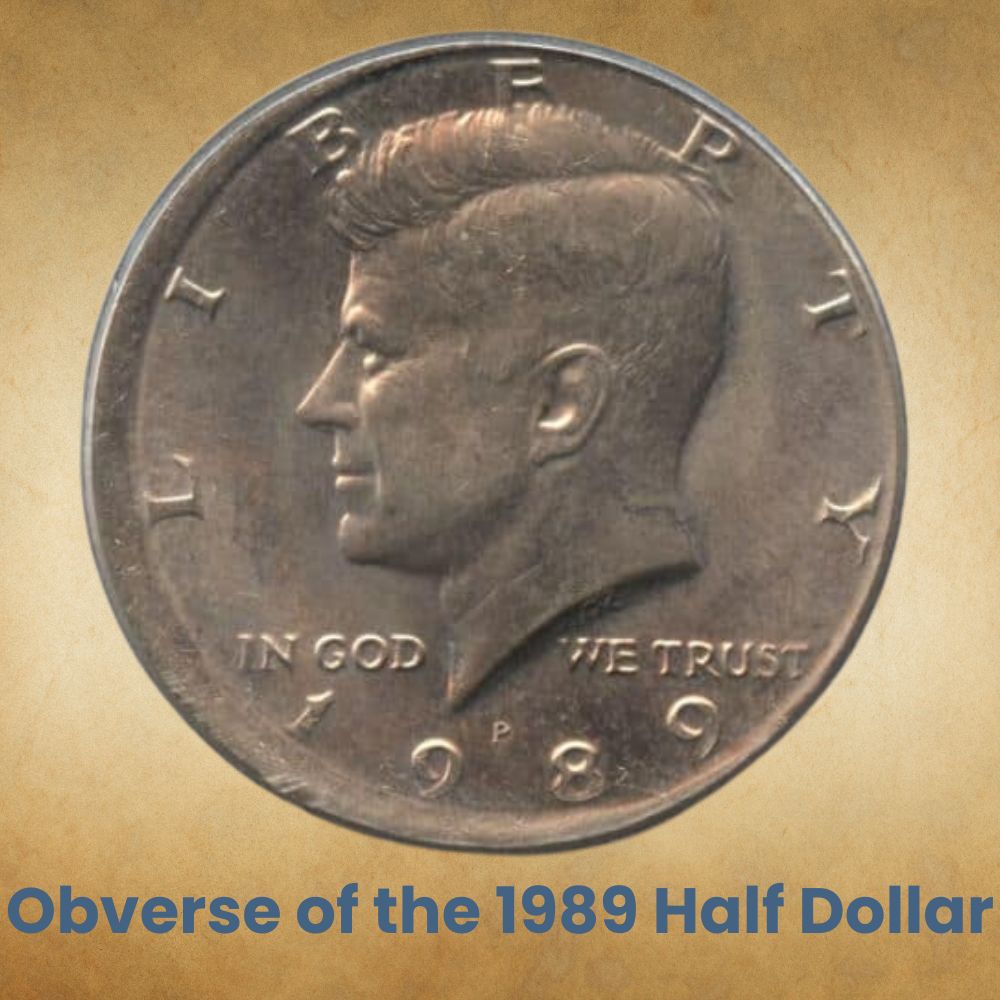
The obverse, also known as the heads, is a coin’s top-facing side. The half dollar from 1989 features President Kennedy’s left-facing portrait on the obverse.
The word LIBERTY is etched around one-half of the coin’s rim while the date, 1989, appears on the bottom portion of the rim.
The motto IN GOD WE TRUST is etched horizontally across the coin’s lower portion.
The Reverse of the 1989 Half Dollar
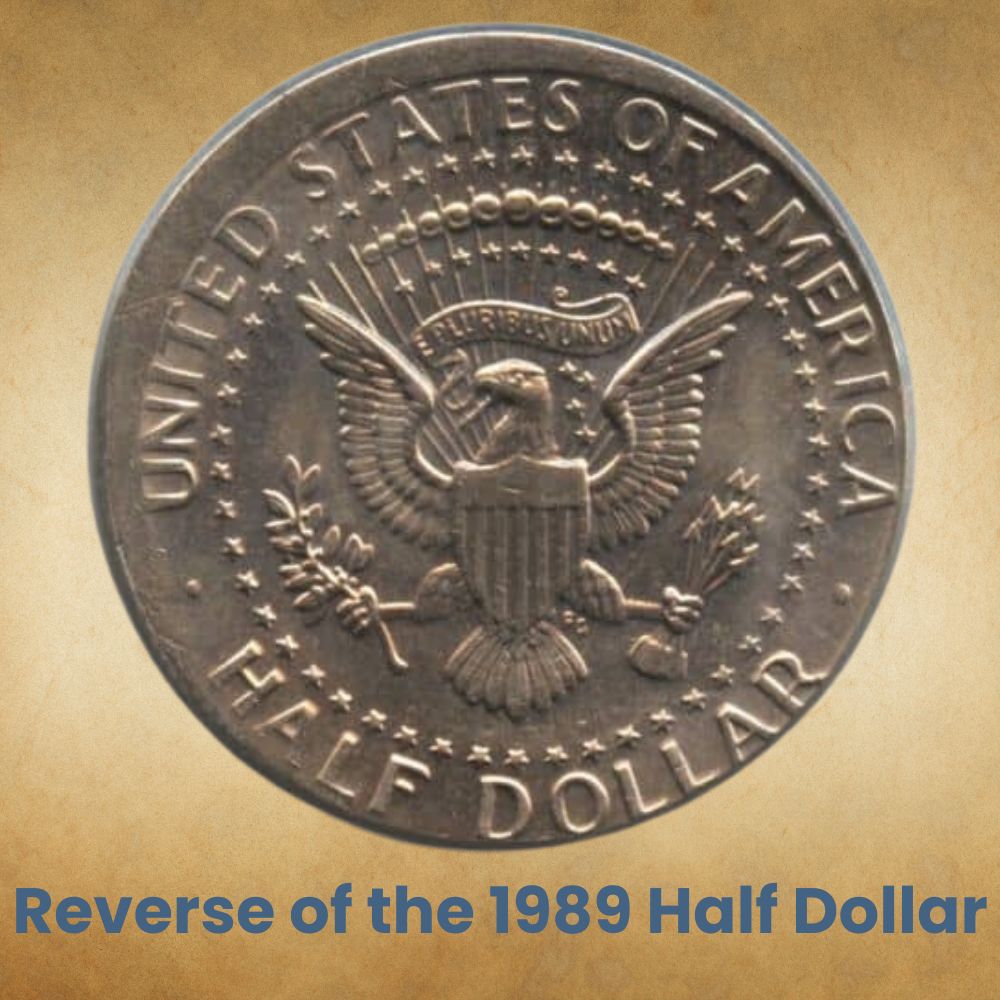
The reverse is also known as the tail and is the back side of a coin. The reverse of the 1989 half dollar features the bald eagle with its wings spread out.
The eagle holds arrows in its left talon and an olive branch in the right, representing readiness to defend the states and peace, respectively.
What appears to be rays of light protrude in the background behind the bald eagle. Nine stars are etched on these rays.
Fifty stars adorn the coin’s circumference to represent the United States of America.
The words UNITED STATES OF AMERICA appear around the coin’s upper rim while the denomination HALF DOLLAR is inscribed around the lower rim.
Other Features of the 1989 Half Dollar
The 1989 Kennedy dollar comprises 91.67% copper and 8.33% nickel.
The coin weighs 11.34 grams and measures 30.6mm in diameter.
These coins spot a mintmark on the obverse just below the truncation of the President’s portrait. Those struck in Philadelphia feature a mintmark P, and those from the Denver mint have a mintmark D on the spot mentioned above.
FAQS
Below are the answers to common questions collectors typically ask about the 1989 half dollar:
Is a 1989 Kennedy half dollar silver?
It is a widespread misconception that all Kennedy half dollars are silver. The Mint first issued the half dollars in 1964 following President Kennedy’s assassination; these coins were 90% silver.
The predominantly silver composition of half dollars remained the same until 1970, when the government’s silver stockpiles ran low, and the precious metal prices skyrocketed. From 1971 onwards, Kennedy half dollars first contained 40% silver and then no silver.
At the dawn of the 1980s, the Mint began using copper and nickel in place of silver to make half dollar coins, and the 1989 half dollar was part of the new copper coins by the U.S. Mint.
How can you tell if your 1989 half dollar is rare?
The truth is 1989 half dollars are not rare. The Mint struck millions of these coins, which still remain in circulation to date. That said, some uncirculated 1989 half dollars are rare.
In particular, those graded MS67 and above are extremely hard to find. Because they are uncirculated, these coins are typically flawless with a sharp strike, shiny surface and without any visible dents or scratches.
These ultra-mint coins can be worth hundreds or thousands of dollars as only a few examples remain.
Can a 1989 half dollar be worth a lot of money?
Due to its high mintage, a 1989 half dollar is worth slightly more than its face value of $0.50 in circulated condition.
There are two instances where a 1989 half dollar could be worth a lot of money i.e. (1) if the coin is in mint state and graded MS66 or (2) the coin is a certified error and draws a lot of numismatic interest, in which case, it could be worth hundreds or thousands of dollars.
All in all, the yardstick is pretty high for a 1989 half dollar to be considered as being worth a lot of money.
